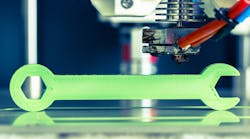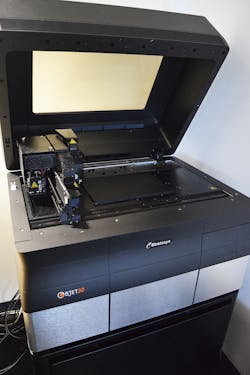3D printing may be associated with consumer products manufacturing with short product lifecycles. In the industrial gas turbine market in particular, design cycles may be a few months or shorter. In addition, the end products can be complex from a dimensional and manufacturability standpoint.
Some engineering departments in industrial manufacturing companies may use 3D printing for functional prototypes or manufacturing at scale. The greater value may come when it is used to drive the cyclic iterative design process.
Now You See It
Engineers may struggle to see a complex part from a drawing. 3D printing is a tangible and direct way to help engineers visualize a part. Once a part is tangible, an engineer can conceptualize it in ways that unlock creativity that can benefit customers.
Many manufactured parts may be complex and multi-faceted, making it difficult to conceive when looking at a representation on a screen. A part may have an 8-inch radius, but may be irregular, with a compound angle in another direction. An engineer may find it difficult to figure out where the parting line would be if they were to make it in two parts. But once they hold a representation in their hand, it becomes clear.
In the industrial gas turbine industry, understanding the dimensional properties of a part is critical because relatively minute dimensional factors may mean a part is not robust enough to survive the rigors it will be exposed to in its lifecycle. For example, a manufacturing team wanted to better understand the relative proportions of several components within a complex assembly. They proceeded to print a 3D model of the assembly, which allowed them to visualize material thicknesses and the overall assembly envelope. During a design review, the engineer could see that the thickness of two of the components was too thin, and the part would surely fail prematurely in service. The use of 3D printing as a visualization tool allowed the team to quickly identify and resolve the issue.
Had the designer not gone through this exercise, the company would have committed to make the product as originally designed, gone through tooling and produced qualification samples, only to discover the deficiencies in design after generating production parts weeks later.
Another example was in a hybrid process were one company printed a metal part and asked an outside design team to machine it to achieve mission-critical tolerances. A design team printed half of the part to understand the finished product. After printing the halved part, the team realized it would never work. When the original company looked at a two-dimensional drawing, it was not apparent they were asking for too much material to be taken off during the machining process. The wall would be too thin, and it could have caused an explosion. The original company 3D printed the part to be machined, but did not use 3D printing as an analytical tool to visualize the final part. The design team came to this conclusion quickly by visualizing both models—as-cast and as-machined analogs—and because 3D printing let the designers look critically at the design.
Innovate at Speed
In relative terms, industrial gas turbine customers are more focused on rapid technological change than are many companies. With unstable costs of fossil fuels and the need to reduce emissions to slow global warming, new product iteration cycles are shrinking dramatically. With these shrinking development cycles, it is important to improve understanding of the emerging design so the design team can make the necessary changes to positively impact cost and performance.
In these situations, a supplier needs to add as much value to the design as quickly as possible before issuing a working prototype. Using 3D printing, they are able to iterate that design multiple times, recognizing and making incremental improvements, before they commit to the first prototype.
The ability of 3D printing to increase the pace of innovation has more to do with people and creativity than technology. Here are three tips for maximizing the innovation impact of 3D printing technology:
1. Make 3D printing about creativity and conceptualization.
The ability to visualize a part in three dimensions, to handle it, perhaps see how it goes together or interlocks with other parts, allows for more rapid, successful designs. This may be the most significant benefit of 3D printing in your industrial engineering department. But in an industrial setting, you can also hand that 3D printed part to the customer, and let them feel it and touch it. This allows the customer to take part in and appreciate your design process in a real and tactile fashion. You can also use the 3D printed part to communicate design intent to the manufacturing team.
But to get to the point where 3D printing becomes a process improvement tool for design, you need to separate the new product introduction and commercialization team from the everyday demands of the business.
It is necessary to create a safe space for innovation by releasing the team from typical performance measures and instead focusing on metrics like time-to-profit for new parts and post-release engineering changes.
Designers should be empowered to create without being pressured to follow a linear design path or reduce iterations so they can be measured on results instead. Did they get it right in the first release or were a number of corrections required after release-to-market?
2. Create an environment where you can iterate the design quickly.
If your organization is structured so an engineer needs to barter for time on the manufacturing floor to access 3D printing, your efforts at rapid iteration will be hampered. Design engineers need to have direct access to tools when they need them with no constraints. Some printers are able to print right in the engineering conference room, or the engineers desk.
This Objet30 3D printer ensures engineers a quick and easy way to test an iteration.
A design department should be able to normally accommodate 3D printing requests within 24 hours. It helps when design and engineering staff are trained to develop and print their own models, and to evaluate outcomes from a cost and manufacturability perspective. With this level of easy access to the technology and cross training, engineers can do a design in the morning, evaluate it in the afternoon and if it is not right, make another change tomorrow.
It may not make sense however to micromanage the 3D printer by tracking usage with scheduling or project management tools. That would just slow the process down. It may make the most sense to look at it as a printer with very expensive paper. At Technetics, engineers sit no more than 75 feet from the printer. Informal and direct communication is needed to agree on who is going to print what when.
3. Have a cross-functional team evaluate each new product.
3D printing lets companies easily involve nontechnical people in the iterative design process. The new product and commercialization team that evaluates these new products requires a mix of people from different departments and with different personalities. From a personality standpoint, you will want:
* 50 percent of the team to be objective-centric.
* 20 percent to 30 percent creative people.
* 10 percent detail-oriented people.
* 10 percent skeptics.
On the one hand, you need to avoid being overwhelmed by detail-oriented people or skeptics because they will slow you down. But without them, you are likely to end up with designs that don’t work. You need them to poke holes in and bring flaws to light at the early stages of development while not criticizing ideas out of existence.
Each participant needs to understand that they are based on their talent and insight rather than their job title in the company.
If they are from the operations department, they can contribute an understanding of operations in your organization. They are not there to prevent processes the operations department would object to. In the new product and commercialization process, there are no solutions that are best for every part of the business. But there are very good products that will be successful for the company, and the team needs to keep that in mind.
Conclusion
In an advanced engineering environment, 3D printing may in some situations be more about concepting and engineering than prototyping and manufacturing. The technology may be used for literal manufacturing in some settings. But in a fast-paced engineering department it can gain even more value when it is used to print something the way one would print a set of plans, but in three dimensions.
A traditional approach relying strictly on CAD images in two dimensions will always be the central strategy in many settings. But in industries characterized by compressed timelines and mission criticality, leveraging 3D printing in the engineering department benefits the customer first by lending speed and accuracy to the new business intake process. Then, the technology can facilitate a new product introduction process that results in faster and more innovative product delivery.
Because of 3D printing and a collaborative, innovative team, a company ours can deliver a high temperature part on a compressed timeline, which is critical given the lightning pace of innovation required by turbine OEM manufacturers. And these parts will perform better and be manufactured more intelligently because of how 3D printing can fuel and inform creative problem solving. Manufacturability, safety, and performance innovations suggest themselves more naturally in three dimensions than two. This in turn allows industrial gas turbine OEMs to deliver a more efficient, durable and safer product to turbine end-users.

